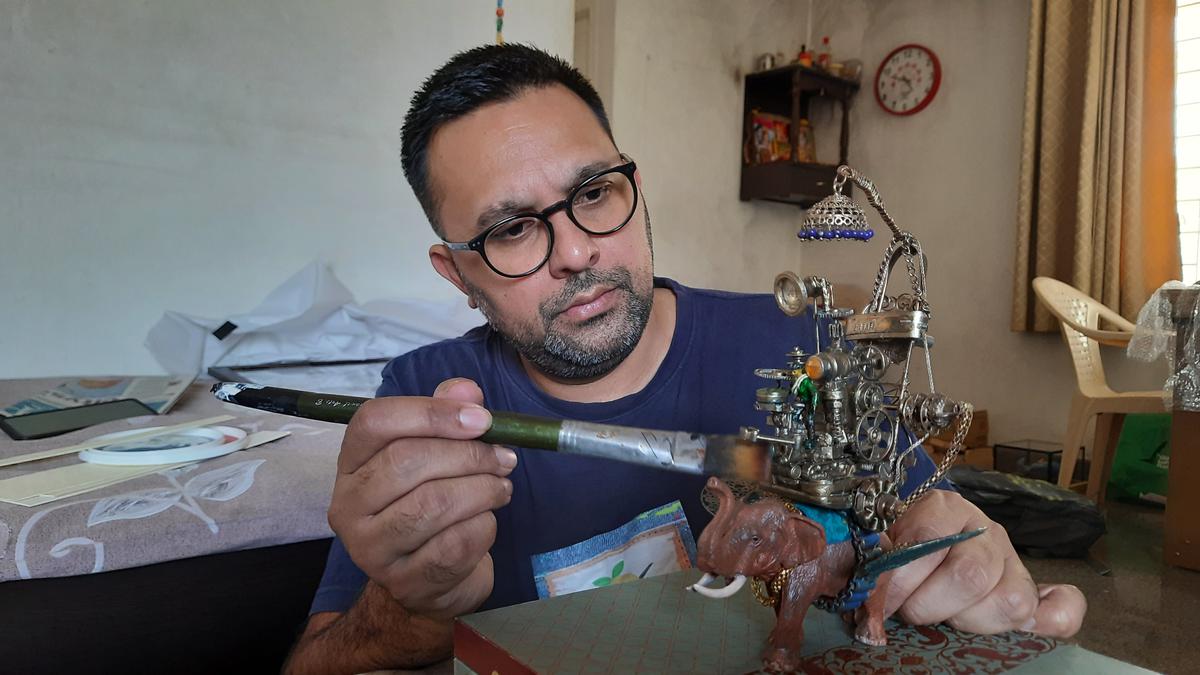When trash becomes art in the hands of Dhiraj Sharma
Dhiraj Sharma gently places his latest creation on the centre table of his living room, a robot-like figure, clearly 90s-inspired, made from an interesting melange of objects. “I’ve named this character Pixie,” says the 40-year-old founder of 8mango, an organisation that transforms junk of all sorts into artefacts and keepsakes. I peer closer, trying to identify Pixie’s various components. His torso is a retro Pepsi can and his legs, composed of e-waste, disappear into trendy high-top sneakers made of discarded binoculars and wristwatches. On his back, Pixie carries an azure backpack, made of an ancient audiocassette while his stiff, LAN-cable arms stand away from his metallic torso, the ends pointing downwards. “He is made of 100% waste,” says Sharma, adding that it started with the can. “I had a Pepsi at the movie theatre, and could not throw the can away. It was too attractive to me,” he says. “Keeping that at the centre, I started building around it.”
It is Sharma’s ability to find inspiration in mundane, discarded objects that make his art so special. Broken jewellery, toys inveigled from his seven-year-old son, the innards of laptops and watches, waste paper, broken bicycle spokes and more are transformed into 3D portraits, small sculptures and quirky artefacts in his able hands. So where does he source his material from, I ask. Almost everywhere, really, he confesses. “I visit scrap yards every weekend,” he says, adding that his friends and family now are aware of his passion and often offer him their discarded items. “They even send pictures,” he says, with a laugh, recalling how his sister had called the previous day, offering a broken printer. And yes, he is also in touch with companies that want to upcycle their e-waste.
Sharma, who grew up in Pune, has been fiddling around with broken devices right from his high school days. “I was curious to see how things look inside, and what can be done, apart from using them in the conventional way,” he says. In 2006, a year or so after he graduated in computer science from Pune University, he launched his website 8mango.com, using the forum to display his artwork. The quirky name of the website came from an early artwork: a bust of Albert Einstein made from the seed of a mango he had eaten.

Dhiraj Sharma of 8mango
| Photo Credit:
Special Arrangement
He still remembers those early days, forging small artefacts over the weekend and at night, in the spare time he got after his day job at a Pune-based animation studio. “I would often keep the small artefacts I had worked on at my desk. People started showing interest and coming over to see them,” he recalls. In 2008, he got his first big break, when he was invited to showcase his work at IIT Bombay’s tech fest. “My first commissioned work was with them. I created a mascot using e-waste and domestic appliances, ” he says, recalling that three-foot tall structure, his very first large-scale project. “The appreciation I got from the crowd and faculty members was overwhelming,” says Sharma, who moved from Pune to Bengaluru in 2010.
Since the IIT showing, there have been many projects, both large and small scale. Some of these include an effigy of Pune’s Victory Theatre, a 10ft x 10ft representation of APJ Abdul Kalam made with discarded x-ray sheets, textured portraits of pop icons such as John Lennon and Frida Kahlo brought alive via scraps of old paper and plastic, and a delightful sculpture of a golden cat shaped out of bike parts and pet bottles.
Sharma is also associated with TEDx Hyderabad, serving as an experience partner with the initiative since 2017, and was part of a show on Sony Entertainment between 2008 and 2011, where he created art from waste, an experience he holds very dear. Currently, he works part-time as a creative advisor for a start-up, juggling both his career and art effortlessly. “When I want to take a break from my job, I do art. When I get exhausted by this, I go back to design,” he says, with a laugh.
I watch him turn back to a work-in-progress, a saxophone made of frayed gas burners and the tarnished base of a globe. He looks up from the artefact and remarks, “Upcycling helps raise the potential of something,” says Sharma. This, in turn, can play a significant role in the larger sustainability narrative, he believes. “In the last 15-odd-years, I alone have converted nearly 200 kg of waste,” he says, adding that he hopes his work will inspire and open more minds to the possibilities offered by upcycling. “The more people are aware of this, the more likely they are to upcycle.”
For all the latest Entertainment News Click Here
For the latest news and updates, follow us on Google News.
